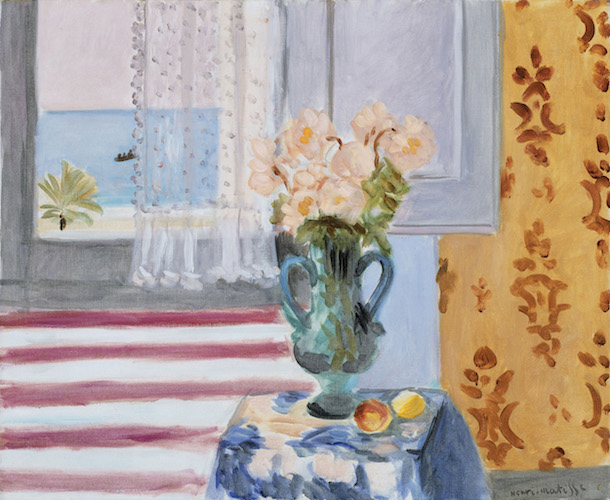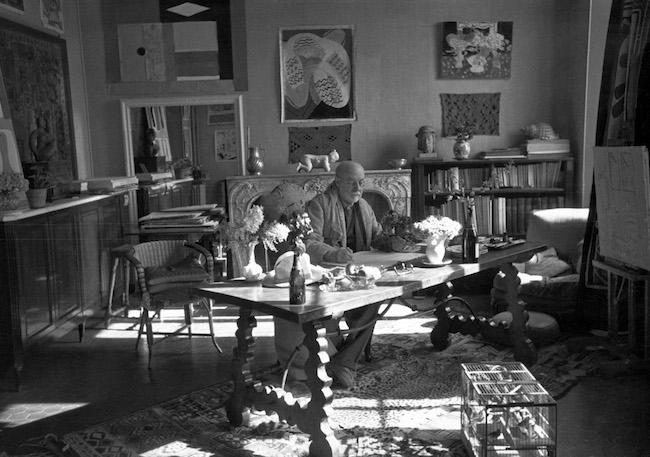Visual Arts Review: Matisse in the Studio — Objects Inspiring Art
Matisse said his objects were his “working library,” sources to mine for formal qualities and their ability to evoke an emotional response.
Matisse in the Studio, at the Museum of Fine Arts Boston, Ann and Graham Gund Gallery, through July 9.

“Vase of Flowers,” Henri Matisse. Photo: courtesy of the Museum of Fine Arts, Boston
By Kathleen Stone
In her book Matisse Stories, A. S. Byatt uses paintings by Henri Matisse as stimulus for the volume’s tales. In one yarn, an uppity painter on the verge of career failure lectures the cleaning lady about why she must not move objects in his studio. He has arranged them just so, he tells her, in order to see the cobalt blue candlestick against the buttercup yellow sauceboat. What’s more, he went into debt to acquire the £ 50 sauceboat because that color was so very important. The cleaning lady listens carefully, keeping her own counsel, and that leads to the final twist of the story which upends assumptions about class and talent. Matisse, who inspired the book, remains a silent presence in the background.
In his own studio, Matisse did in fact surround himself with the colorful objects he used as subject matter for his work, catalysts for his unique artistic vision. That is the driving idea behind the show Matisse in the Studio, a premise the MFA curators effectively mine to trace the evolution of the artist’s work.

Photograph by Henri Cartier-Bresson of Matisse with his collection of Kuba cloths and a Samoan tapa on the wall behind him, Villa La Rêve, Vence, 1944. Photo: courtesy Museum of Fine Arts, Boston.
A large black and white photo shows the artist at a writing table in his studio. Around him is arranged what fueled his work: vases full of flowers on the desk, figurative sculptures and a silver chocolate pot behind him, kube cloth on the wall. These and other artifacts collected from the artist’s studio, most of them now owned by Musée Matisse in Nice, are on display along with a compact but revealing selection of paintings, studies, cut-outs, and sculptures.
Matisse is known as a colorist, one of the Fauves, and he uses objects as a point of departure to explore color, volume, and perspective. Two paintings from the early years make the point. In Vase of Flowers, from 1924, he places flowers in a green vase in front of a window. The vase itself, shown nearby, is a piece of blown glass from Spain, and it appears again in the 1925 Sofrano Roses at the Window. But the second time, it looks different – more mottled and bluer – putting the lie to any notion of constancy of physical properties. Then there is the matter of angles. In the earlier painting, Matisse defines the walls, window, and floor with right angles and flat color. In the second picture, everything is vertiginous. The viewer’s sight line is squeezed against the wall and the table tips forward; vase and fruit are ready to spill onto the floor. The comparatively muted tones in the first painting are replaced by a brighter palette. Matisse is experimenting here. He anchors his work on the Spanish vase, but then manipulates everything around the object to achieve wildly different results.
Matisse never stopped experimenting. He said his objects were his “working library,” sources to mine for formal qualities and their ability to evoke an emotional response. They came from many cultures, but those from Africa catapulted his art into new directions. As early as 1906, he acquired a Vili figure from the Democratic Republic of Congo (then ruled by Belgium) and prayer rugs and ceramics from Algeria (then under French governance); within two years, he had twenty African figures and masks.
His objects exerted their influence gradually. In a 1907 still life, a Fang reliquary figure appears, but only to play a supporting role. The primary focus of the painting is a French pewter jug; it is as though Matisse is still absorbing what he can from the figure. By 1914, in Still Life with Violet Stockings, he applies a new sense of geometry to a Parisian prostitute with her purple stockings. Given her elongated and flattened chest and the decidedly angular features of her face, the statue’s influence is clear.
Matisse worked differently than his friend and rival Pablo Picasso. Both used African art to shape their innovations, but Picasso’s Les Demoiselles d ‘Avignon (1907), considered the first truly cubist painting, is radical and explosive; Matisse’s evolution was gentler. He never truly embraced cubism, but used color and pattern like no one else.

“Head of Jeannette V,” Henri Matisse. (cast 1954) Bronze. Photograph by Cathy Carver. Photo: courtesy of Museum of Fine Arts, Boston.
The late canvas Interior with Egyptian Curtain (1948) is stunning: pink table with yellow fruits, window frame full of green and blue palm fronds, red, green and black curtain hanging in front of the glass. The Egyptian curtain from the painting and several haiti (pierced and appliquéd cotton hangings) are on display, and we can see how their intricate patterns intoxicated Matisse. He used textiles as background in The Moorish Screen (1921), but also allowed them to take over the entire picture plane, rendering background and foreground a distinction without a difference, as with Interior with Egyptian Curtain. Pattern and color are the primary compositional elements, more important than the quasi-realistic appearance of what is ostensibly the subject of the painting.
To understand Matisse as a colorist, don’t miss Still Life with Heron Studies (1900), a small piece in the second room of the exhibit. He’s a young artist applying splotches of paint – mostly oranges and blues – in order to see them together. It’s as though he is anticipating Matisse Stories: arranging objects in his studio, seeing colors set against each other.
Near the end of his life, Matisse designed a chapel for Dominican nuns in Vence, France. He attended to the smallest details, including vestments for the priests. Maquettes, or mock-ups, for the clerical robes are on display. Wrought out of color, simplified form, and a pattern of black crosses, they are a distillation of his life’s work.
One aspect of the show that feels unsatisfactory to me is the reference to appropriation. Text on the walls use the word, and it is a term that carries a negative connotation. While there is plenty to say about attitudes toward non-European art, it is also true that artists use other art to stimulate their own development. Studio visits, museum sketches, literature, music and, as with Matisse, tactile objects, all have a role in fueling artistic growth and inspiration. It seems unnecessary to suggest that there is something amiss. The curatorial team, Helen Burnham from the MFA, Ellen McBreen from Wheaton College, and Ann Dumas from London’s Royal Academy of Arts, undoubtedly have more to say on the subject, but they are limited by the size and format of the wall labels. Perhaps the topic will be addressed in the series of lectures the museum is offering on Matisse, or when the show makes its next stop at the Royal Academy of Arts in London.
Kathleen Stone lives in Boston and writes critical reviews for The Arts Fuse. She co-hosts a literary salon known as Booklab and is at work on several long projects. She holds graduate degrees from the Bennington Writing Seminars and Boston University School of Law, and her blog can be found here.
